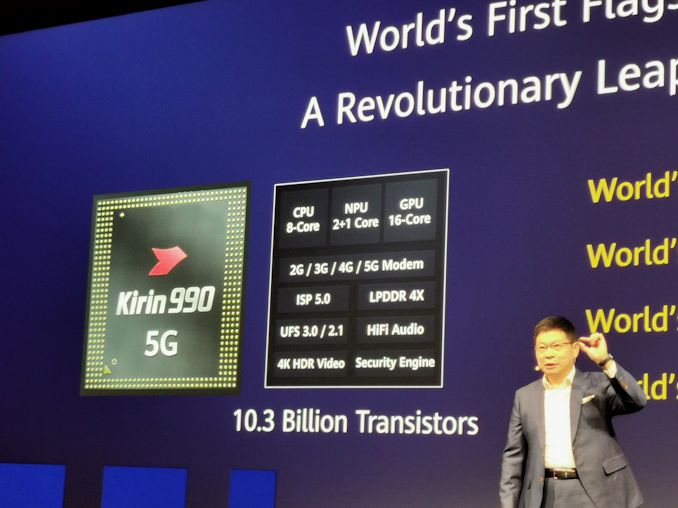TSMC: N7+ EUV Process Technology in High Volume, 6nm (N6) Coming Soon
by Anton Shilov on October 8, 2019 2:00 PM ESTTSMC announced on Monday that its customers have started shipping products based on chips made by TSMC using its N7+ (2nd Generation 7 nm with EUV) process technology that uses extreme ultraviolet lithography (EUVL) for up to four layers. The company also said that its clients are on track to tape out chips to be made using N6 node next year.
When compared to N7 (1st Generation 7 nm) that solely relies on deep ultraviolet lithography, TSMC lists its N7+ process as providing a 15% to 20% higher transistor density as well as 10% lower power consumption at the same complexity and frequency. Furthermore, after less than two quarters in production, TSMC is stating that N7+ now matches N7’s yields, which has been used for over a year now.
Use of EUVL enables TSMC to reduce usage of multipatterning technologies when printing highly complex circuits. This also means that TSMC’s EUV tools can offer output power of greater than 250 watts for day-to-day operations while reaching target goals for availability.
| Advertised PPA Improvements of New Process Technologies Data announced by companies during conference calls, press briefings and in press releases |
|||||||||
| TSMC | |||||||||
| 16FF+ vs 20SOC |
10FF vs 16FF+ |
7FF vs 16FF+ |
7FF vs 10FF |
7FF+ vs 7FF |
6FF vs 7FF |
5FF vs 7FF |
|||
| Power | 60% | 40% | 60% | <40% | 10% | ? | 20% | ||
| Performance | 40% | 20% | 30% | ? | same (?) | ? | 15% | ||
| Area Reduction | none | >50% | 70% | >37% | ~17% | 18% | 45% | ||
At present, TSMC uses N7+ to produce chips for multiple customers. The most prominent customer of N7+ is Huawei's Hisilicon with the Kirin 990 5G.
TSMC is on track to start risk production of semiconductors using its N6 process technology in the first quarter of 2020 and initiate high-volume production using this node by the end of next year. TSMC’s N6 is a further development of N7 that offers 18% higher transistor density, uses EUVL for up to five layers and enables designers of chips to re-use the same design ecosystem (e.g., tools, IP, etc.), which lowers development costs. By contrast, N7+ uses different design rules, but also provides more benefits than N6 when compared to N7.
Related Reading
- TSMC Announces Performance-Enhanced 7nm & 5nm Process Technologies
- TSMC: Most 7nm Clients Will Transition to 6nm
- TSMC Reveals 6 nm Process Technology: 7 nm with Higher Transistor Density
- TSMC’s 5nm EUV Making Progress: PDK, DRM, EDA Tools, 3rd Party IP Ready
- TSMC: 7nm Now Biggest Share of Revenue
- TSMC: First 7nm EUV Chips Taped Out, 5nm Risk Production in Q2 2019
- TSMC Details 5 nm Process Tech: Aggressive Scaling, But Thin Power and Performance Gains
Source: TSMC











27 Comments
View All Comments
sgeocla - Tuesday, October 8, 2019 - link
According to TSMC slides, N7+ vs. N7 can also provide +10% performance at iso-power.So we could see clock speed increases vs. N7. Using a balanced frequency vs. power increase, even a 6% increase in clock speeds could make a next gen Ryzen 4950x reach 5GHz boost while using the same or lower power than a Ryzen 3950x.
patel21 - Tuesday, October 8, 2019 - link
improving IPC and keeping the same frequency while reducing power will be even more awesome.AshlayW - Tuesday, October 8, 2019 - link
Clock speed is the last and final hurdle for AMD to conquer with Zen. I hope the next generation will allow for 5 GHz turbo frequencies on a few cores, to acellerate single-threaded applications even more so than Intel's many Lakes can right now. Allowing the chips to reach high frequencies for lightly threaded tasks doesn't mean it won't consume less power for heavily threaded ones.FreckledTrout - Tuesday, October 8, 2019 - link
Yes but TSMC can not help with IPC. This is why nobody is mentioning it in regards to the process.Alistair - Tuesday, October 8, 2019 - link
It can improve IPC in the sense that you get more transistors per area.FreckledTrout - Wednesday, October 9, 2019 - link
Yeah sure but doesn't help IPC unless AMD does a new design for said process.FreckledTrout - Tuesday, October 8, 2019 - link
Also let's not forget TSMC's 7nm process is creating AMD chiplets with only 1 or 2 cores that can hit those boost clocks. I expect EUV is going to help with the consistency of good cores so hopefully in the lower core counts we will see higher base clocks as well as boost clocks.GreenReaper - Tuesday, October 8, 2019 - link
I'd have thought they'll push the frequencies again to have a higher base and higher single-core. After all, this provides the most advertised performance. Kinda sucks for overclocking, but you get a good value for what you pay for to start with.dudedud - Tuesday, October 8, 2019 - link
"Two known customers of N7+ are Huawei's Hisilicon with the Kirin 990 5G, and Apple’s A13."Is now confirmed that the A13 is indeed on 7+?
Valantar - Wednesday, October 9, 2019 - link
Given the size of Apple's recent SoCs I would be quite shocked if they didn't go for the hightest-end process possible at all times. Which I believe is also what they've done previously.